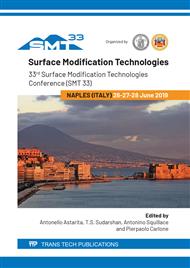p.404
p.411
p.417
p.423
p.429
p.435
p.441
p.447
p.453
Tantalum Based High-Pressure Cold Spray Coatings on Stainless Steel Substrate
Abstract:
Tantalum as a transition element possesses good corrosion resistant properties, along with ductility and hardness. It is also one of the best heat-resistant material (melting point 2996°C) and is known for its high heat and electrical conductivity. In this research, Tantalum is deposited on stainless steel substrate using high-pressure cold spray (HPCS) method. Cold spray coating technology enables the deposition of powder feedstock without melting. Feedstock particles are propelled through a nozzle at supersonic velocities and they deform plastically on impact, resulting in good bonding strength to the substrate. The low temperature and solid-state deposition associated with cold spray allows refractory materials such as Ta, Mo, and W to be deposited without high temperature requirements. The objective of this work is to achieve a dense and nonporous coating microstructure with a high deposition efficiency. The hardness of as-received tantalum particles is found to be 279 HV0.3 and the microstructure is very dense. Tensile testing carried on the sample coated at a stagnation gas pressure of 50 bar and gas inlet temperature of 900°C exhibited an ultimate tensile strength of 442 MPa and adhesion strength of 77 MPa. Further mechanical properties of the coating in terms of hardness is carried out by nanoindentation. These results will be correlated with microstructural imaging and elemental analysis including morphology and composition using scanning electron microscopy and X-ray diffraction techniques.
Info:
Periodical:
Pages:
429-434
Citation:
Online since:
July 2019
Price:
Сopyright:
© 2019 Trans Tech Publications Ltd. All Rights Reserved
Share:
Citation:


